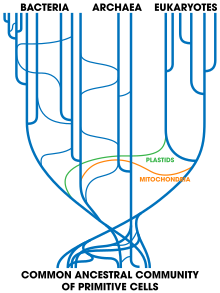
Horizontal gene transfer (HGT) or lateral gene transfer (LGT)[1][2][3] is the movement of genetic material between organisms other than by the ("vertical") transmission of DNA from parent to offspring (reproduction).[4] HGT is an important factor in the evolution of many organisms.[5][6] HGT is influencing scientific understanding of higher-order evolution while more significantly shifting perspectives on bacterial evolution.[7]
Horizontal gene transfer is the primary mechanism for the spread of antibiotic resistance in bacteria,[8][5][9][10] and plays an important role in the evolution of bacteria that can degrade novel compounds such as human-created pesticides[11] and in the evolution, maintenance, and transmission of virulence.[12] It often involves temperate bacteriophages and plasmids.[13][14][15] Genes responsible for antibiotic resistance in one species of bacteria can be transferred to another species of bacteria through various mechanisms of HGT such as transformation, transduction and conjugation, subsequently arming the antibiotic resistant genes' recipient against antibiotics. The rapid spread of antibiotic resistance genes in this manner is becoming a challenge to manage in the field of medicine. Ecological factors may also play a role in the HGT of antibiotic resistant genes.[16]
Horizontal gene transfer is recognized as a pervasive evolutionary process that distributes genes between divergent prokaryotic lineages[17] and can also involve eukaryotes.[18][19] HGT events are thought to occur less frequently in eukaryotes than in prokaryotes. However, growing evidence indicates that HGT is relatively common among many eukaryotic species and can have an impact on adaptation to novel environments. Its study, however, is hindered by the complexity of eukaryotic genomes and the abundance of repeat-rich regions, which complicate the accurate identification and characterization of transferred genes.[20][21]
It is postulated that HGT promotes the maintenance of a universal life biochemistry and, subsequently, the universality of the genetic code.[22]
- ^ Ochman H, Lawrence JG, Groisman EA (May 2000). "Lateral gene transfer and the nature of bacterial innovation". Nature. 405 (6784): 299–304. Bibcode:2000Natur.405..299O. doi:10.1038/35012500. PMID 10830951. S2CID 85739173.
- ^ Dunning Hotopp JC (April 2011). "Horizontal gene transfer between bacteria and animals". Trends in Genetics. 27 (4): 157–63. doi:10.1016/j.tig.2011.01.005. PMC 3068243. PMID 21334091.
- ^ Robinson KM, Sieber KB, Dunning Hotopp JC (October 2013). "A review of bacteria-animal lateral gene transfer may inform our understanding of diseases like cancer". PLOS Genetics. 9 (10): e1003877. doi:10.1371/journal.pgen.1003877. PMC 3798261. PMID 24146634.
- ^ Keeling PJ, Palmer JD (August 2008). "Horizontal gene transfer in eukaryotic evolution". Nature Reviews. Genetics. 9 (8): 605–18. doi:10.1038/nrg2386. PMID 18591983. S2CID 213613.
- ^ a b Gyles C, Boerlin P (March 2014). "Horizontally transferred genetic elements and their role in pathogenesis of bacterial disease". Veterinary Pathology. 51 (2): 328–40. doi:10.1177/0300985813511131. PMID 24318976. S2CID 206510894.
- ^ Vaux F, Trewick SA, Morgan-Richards M (2017). "Speciation through the looking-glass". Biological Journal of the Linnean Society. 120 (2): 480–488. doi:10.1111/bij.12872.
- ^ Ochman H, Lerat E, Daubin V (May 2005). "Examining bacterial species under the specter of gene transfer and exchange". Proceedings of the National Academy of Sciences of the United States of America. 102 (Suppl 1): 6595–6599. Bibcode:2005PNAS..102.6595O. doi:10.1073/pnas.0502035102. PMC 1131874. PMID 15851673.
- ^ Huddleston JR (2014). "Horizontal gene transfer in the human gastrointestinal tract: potential spread of antibiotic resistance genes". Infection and Drug Resistance. 7: 167–176. doi:10.2147/idr.s48820. PMC 4073975. PMID 25018641.
- ^ Koonin EV, Makarova KS, Aravind L (2001). "Horizontal gene transfer in prokaryotes: quantification and classification". Annual Review of Microbiology. 55 (1): 709–42. doi:10.1146/annurev.micro.55.1.709. PMC 4781227. PMID 11544372.
- ^ Nielsen KM (1998). "Barriers to horizontal gene transfer by natural transformation in soil bacteria". APMIS. 84 (S84): 77–84. doi:10.1111/j.1600-0463.1998.tb05653.x. PMID 9850687. S2CID 26490197.
- ^ McGowan C, Fulthorpe R, Wright A, Tiedje JM (October 1998). "Evidence for interspecies gene transfer in the evolution of 2,4-dichlorophenoxyacetic acid degraders". Applied and Environmental Microbiology. 64 (10): 4089–92. Bibcode:1998ApEnM..64.4089M. doi:10.1128/AEM.64.10.4089-4092.1998. PMC 106609. PMID 9758850.
- ^ Keen EC (December 2012). "Paradigms of pathogenesis: targeting the mobile genetic elements of disease". Frontiers in Cellular and Infection Microbiology. 2: 161. doi:10.3389/fcimb.2012.00161. PMC 3522046. PMID 23248780.
- ^ Naik GA, Bhat LN, Chpoade BA, Lynch JM (1994). "Transfer of broad-host-range antibiotic resistance plasmids in soil microcosms". Curr. Microbiol. 28 (4): 209–215. doi:10.1007/BF01575963. S2CID 21015053.
- ^ Varga M, Kuntová L, Pantůček R, Mašlaňová I, Růžičková V, Doškař J (July 2012). "Efficient transfer of antibiotic resistance plasmids by transduction within methicillin-resistant Staphylococcus aureus USA300 clone". FEMS Microbiology Letters. 332 (2): 146–52. doi:10.1111/j.1574-6968.2012.02589.x. PMID 22553940.
- ^ Varga M, Pantu Ček R, Ru Žičková V, Doškař J (January 2016). "Molecular characterization of a new efficiently transducing bacteriophage identified in meticillin-resistant Staphylococcus aureus". The Journal of General Virology. 97 (1): 258–268. doi:10.1099/jgv.0.000329. PMID 26537974.
- ^ Cairns J, Ruokolainen L, Hultman J, Tamminen M, Virta M, Hiltunen T (2018-04-19). "Ecology determines how low antibiotic concentration impacts community composition and horizontal transfer of resistance genes". Communications Biology. 1 (1): 35. doi:10.1038/s42003-018-0041-7. PMC 6123812. PMID 30271921.
- ^ Zhou H, Beltrán JF, Brito IL (October 2021). "Functions predict horizontal gene transfer and the emergence of antibiotic resistance". Science Advances. 7 (43): eabj5056. Bibcode:2021SciA....7.5056Z. doi:10.1126/sciadv.abj5056. PMC 8535800. PMID 34678056.
- ^ Sieber KB, Bromley RE, Dunning Hotopp JC (September 2017). "Lateral gene transfer between prokaryotes and eukaryotes". Experimental Cell Research. 358 (2): 421–426. doi:10.1016/j.yexcr.2017.02.009. PMC 5550378. PMID 28189637.
- ^ Gabaldón T (October 2021). "Origin and Early Evolution of the Eukaryotic Cell". Annual Review of Microbiology. 75 (1): 631–647. doi:10.1146/annurev-micro-090817-062213. PMID 34343017. S2CID 236916203.
- ^ Brockhurst MA, Harrison E, Hall JP, Richards T, McNally A, MacLean C (October 2019). "The Ecology and Evolution of Pangenomes". Current Biology. 29 (20): R1094–R1103. Bibcode:2019CBio...29R1094B. doi:10.1016/j.cub.2019.08.012. ISSN 0960-9822. PMID 31639358.
- ^ Van Etten J, Bhattacharya D (December 2020). "Horizontal Gene Transfer in Eukaryotes: Not if, but How Much?". Trends in Genetics. 36 (12): 915–925. doi:10.1016/j.tig.2020.08.006. PMID 33012528.
- ^ Kubyshkin V, Acevedo-Rocha CG, Budisa N (February 2018). "On universal coding events in protein biogenesis". Bio Systems. 164: 16–25. Bibcode:2018BiSys.164...16K. doi:10.1016/j.biosystems.2017.10.004. PMID 29030023.